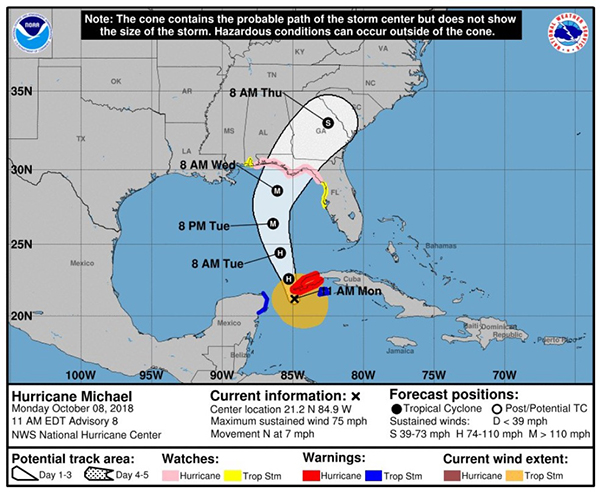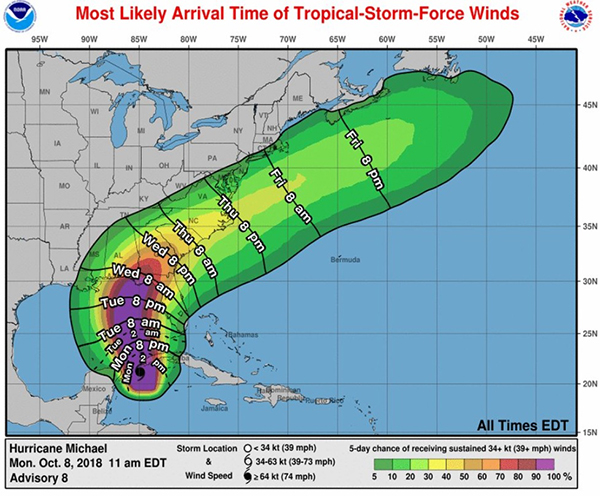According to the
National Hurricane Center, Hurricane Michael is centered this morning about 50 miles (80 km) south of the western tip of Cuba and 140 miles (220 km) east of Cozumel, Mexico. Michael has maximum sustained winds of 75 mph and is moving north at approximately 7 mph. A Hurricane Watch has been issued for the Florida Panhandle, including Escambia County. Steady to rapid strengthening is forecast during the next day or so, and Michael is forecast to become a major hurricane by Tuesday or Tuesday night.
On the forecast track, the center of Michael will move northward near the western tip of Cuba this afternoon and into the southeastern Gulf of Mexico by tonight. Michael will move across the eastern Gulf of Mexico Tuesday and Tuesday night, and is expected to move inland over the Florida Panhandle or Florida Big Bend area on Wednesday, and then move northeastward across the southeastern United States Wednesday night and Thursday.
It
is still too early to determine what direct impacts the Hurricane Michael might have on Escambia County and Northwest Florida, but according to the
National Weather Service in Mobile,
strong winds, storm surge, flash flood conditions and deadly rip currents are likely across portions of the northern Gulf Coast. Impacts are dependent on the track of this system.
A high risk of rip currents and high surf advisory are in effect for the northern Gulf Coast through at least Thursday.
Red flags are flying on Pensacola Beach and are expected through Thursday. Red flags represent high surf and/or dangerous currents, and there is no swimming or wading in the Gulf of Mexico in red flag conditions. Only experienced surfers with a surfboard and leash are allowed to enter the Gulf. Surf heights are forecast to increase to 3-5 feet today, 5-8 feet by Tuesday, and 8-10 feet by Wednesday, according to NWS Mobile.
Escambia County Emergency Management is closely monitoring this system, including participating in weather conference calls with the National Weather Service and state. Residents are urged to do the same by
monitoring our local media for the most up-to-date forecasts several times a day.
Residents should also take the time now to double check their storm supplies and preparations so that if and when a confirmed threat develops, they are ready. The key to reducing the stress and impact on your family is to prepare by taking the following steps:
Review or make a family plan. This includes:
- Knowing your evacuation zone is one of the most important hurricane preparation steps you can take. It is very important that you look up your evacuation zone each year to find out if and when you should evacuate, even if you have looked it up in the past, as zones can change. Most importantly, don’t rely on previous storm experience. Just because you weathered the last storm, doesn’t mean you will weather this one. Look up your address online at myescambia.com/knowyourzone.
- Know where you will go. If you live in an evacuation zone, know where you will go and how you will get there. Will you go to a friend or relative’s home, a hotel, or as a last resort, a public shelter? It is always easier to go tens of miles, not hundreds. Find a list of shelters, including special needs and pet-friendly, here.
- Have a communication plan. Plan now how you will contact one another and where you will meet.
- Plan for those with special needs. Make arrangements in advance to accommodate those in your family with special needs like the elderly, children and pets. Always have at least an extra 3-10 days stock of medical supplies, medication and any other special items you may need.
- Understand Watch vs. Warning, the hurricane cone and what steps you need to take when. Learn more by clicking here.
- Take photos of important documents and your valuables. Save these to a secure cloud site, thumb drive or keep on your mobile device.
Get a kit - Your disaster kit should have at least three days of nonperishable food and three gallons of water for each person and pet in your home, along with other supplies. Click here to see our latest disaster guide shopping list.
Stay informed - A tropical system can develop very quickly. Be sure you take time every day to monitor the local media. Escambia County also has several tools available for our residents. Learn more here. Monitor local media and legitimate online and social media sources like Escambia County Emergency Management, US National Weather Service Mobile, NOAA NWS National Hurricane Center and Florida SERT.
Prep your yard - During hurricane season, it is also recommended that residents take a few minutes to inspect their home and yard. Check for, fix or remove loose items on your home and sheds. Clear loose and clogged rain gutters and down spouts. Learn more here.







